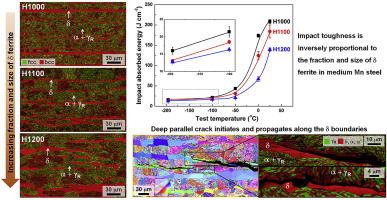当前位置:
X-MOL 学术
›
Acta Mater.
›
论文详情
Our official English website, www.x-mol.net, welcomes your
feedback! (Note: you will need to create a separate account there.)
Crucial microstructural feature to determine the impact toughness of intercritically annealed medium-Mn steel with triplex-phase microstructure
Acta Materialia ( IF 8.3 ) Pub Date : 2019-02-01 , DOI: 10.1016/j.actamat.2018.10.043 Min Tae Kim , Tak Min Park , Kyeong-Ho Baik , Won Seok Choi , Pyuck-Pa Choi , Jeongho Han
Acta Materialia ( IF 8.3 ) Pub Date : 2019-02-01 , DOI: 10.1016/j.actamat.2018.10.043 Min Tae Kim , Tak Min Park , Kyeong-Ho Baik , Won Seok Choi , Pyuck-Pa Choi , Jeongho Han

|
Abstract We investigated the correlation between the impact toughness and microstructures of annealed Fe-8Mn-0.2C-3Al-1.3Si (wt.%) steel to identify the key microstructural feature determining the impact toughness of medium-Mn steel. The microstructural constituents were varied by changing the hot-rolling temperature in the range of 1000–1200 °C before intercritical annealing. The annealed steels exhibited a triplex-phase microstructure consisting of δ ferrite with coarse grains and an elongated structure along the rolling and transverse directions and nanolaminate α martensite plus γR retained austenite with ultrafine size. While the volume fraction of γR remained almost constant regardless of the hot-rolling temperature, the volume fraction of δ increased and that of α decreased with increase in the hot-rolling temperature. The average grain size for all phases increased with the hot-rolling temperature. The stability of γR decreased with the increase of the hot-rolling temperature owing to grain coarsening and a reduction in the Mn and C concentrations. A lower hot-rolling temperature resulted in improved impact toughness. We observed that deep parallel cracks formed and propagated along the δ interface decorated with Mn, ultimately causing a fracture. This result indicates that δ ferrite was the crucial factor determining the toughness among the existing phases, and the steels with a higher fraction of δ exhibited a lower impact toughness. The decrease of the retained austenite stability and the increase of the size of prior γ grains with increasing hot-rolling temperature were identified as other microstructural factors determining the impact toughness.
中文翻译:

确定具有三相显微组织的临界退火中锰钢的冲击韧性的关键显微组织特征
摘要 我们研究了退火后的 Fe-8Mn-0.2C-3Al-1.3Si (wt.%) 钢的冲击韧性和显微组织之间的相关性,以确定决定中锰钢冲击韧性的关键显微组织特征。在临界区退火之前,通过在 1000-1200°C 范围内改变热轧温度来改变显微组织成分。退火钢呈现三相组织,由粗大晶粒的δ铁素体和沿轧制和横向的细长组织和纳米层状α马氏体+γR残余奥氏体组成,具有超细尺寸。γR 的体积分数与热轧温度无关,几乎保持不变,δ 的体积分数增加,α 的体积分数随着热轧温度的升高而减少。所有相的平均晶粒尺寸随着热轧温度的增加而增加。由于晶粒粗化和Mn和C浓度的降低,γR的稳定性随着热轧温度的升高而降低。较低的热轧温度导致改进的冲击韧性。我们观察到深平行裂纹形成并沿用 Mn 装饰的 δ 界面扩展,最终导致断裂。该结果表明δ铁素体是决定现有相中韧性的关键因素,δ含量较高的钢表现出较低的冲击韧性。随着热轧温度的升高,残余奥氏体稳定性的降低和原始γ晶粒尺寸的增加被认为是决定冲击韧性的其他显微组织因素。
更新日期:2019-02-01
中文翻译:

确定具有三相显微组织的临界退火中锰钢的冲击韧性的关键显微组织特征
摘要 我们研究了退火后的 Fe-8Mn-0.2C-3Al-1.3Si (wt.%) 钢的冲击韧性和显微组织之间的相关性,以确定决定中锰钢冲击韧性的关键显微组织特征。在临界区退火之前,通过在 1000-1200°C 范围内改变热轧温度来改变显微组织成分。退火钢呈现三相组织,由粗大晶粒的δ铁素体和沿轧制和横向的细长组织和纳米层状α马氏体+γR残余奥氏体组成,具有超细尺寸。γR 的体积分数与热轧温度无关,几乎保持不变,δ 的体积分数增加,α 的体积分数随着热轧温度的升高而减少。所有相的平均晶粒尺寸随着热轧温度的增加而增加。由于晶粒粗化和Mn和C浓度的降低,γR的稳定性随着热轧温度的升高而降低。较低的热轧温度导致改进的冲击韧性。我们观察到深平行裂纹形成并沿用 Mn 装饰的 δ 界面扩展,最终导致断裂。该结果表明δ铁素体是决定现有相中韧性的关键因素,δ含量较高的钢表现出较低的冲击韧性。随着热轧温度的升高,残余奥氏体稳定性的降低和原始γ晶粒尺寸的增加被认为是决定冲击韧性的其他显微组织因素。


















































 京公网安备 11010802027423号
京公网安备 11010802027423号